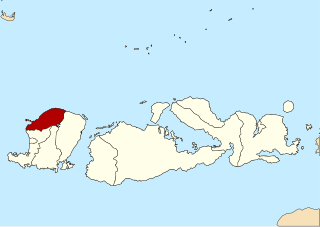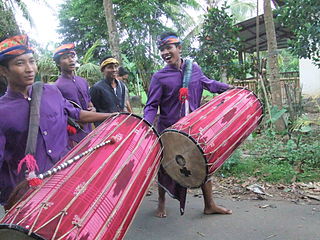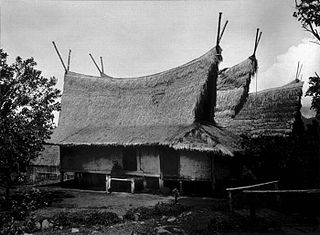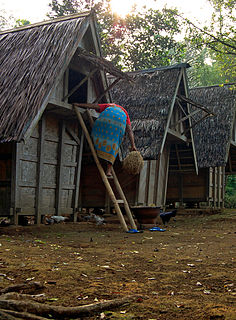
Lombok is an island in West Nusa Tenggara province, Indonesia. It forms part of the chain of the Lesser Sunda Islands, with the Lombok Strait separating it from Bali to the west and the Alas Strait between it and Sumbawa to the east. It is roughly circular, with a "tail" to the southwest, about 70 kilometres across and a total area of about 4,514 square kilometres. The provincial capital and largest city on the island is Mataram.

The Sasak people live mainly on the island of Lombok, Indonesia, numbering around 3.6 million. They are related to the Balinese in language and ancestry, although the Sasak are predominantly Muslim while the Balinese are predominantly Hindu. Sasak people who practice pre-Islamic beliefs are also known as Sasak Boda in reference to the name of the Sasak people's original religion, Bodha.

Mataram is the capital of the Indonesian province of West Nusa Tenggara. The city is surrounded on all the landward sides by West Lombok Regency and lies on the western side of the island of Lombok, Indonesia. It is also the largest city of the province, and had a population of 402,296 at the 2010 Census; the latest official estimate is 420,941.

The Gili Islands are an archipelago of three small islands or Gili island triplets — Gili Trawangan, Gili Meno and Gili Air — just off the northwest coast of Lombok, Indonesia.

The Sasak language is spoken by the Sasak ethnic group, which make up the majority of the population of Lombok in Indonesia. It is closely related to the Balinese and Sumbawa languages spoken on adjacent islands, and is part of the Austronesian language family. Sasak has no official status; the national language, Indonesian, is the official and literary language in areas where Sasak is spoken.

The architecture of Indonesia reflects the diversity of cultural, historical and geographic influences that have shaped Indonesia as a whole. Invaders, colonizers, missionaries, merchants and traders brought cultural changes that had a profound effect on building styles and techniques.

A rice barn is a type of barn used worldwide for the storage and drying of harvested rice. The designs, usually specialized to its function, and it may vary between countries or between provinces. Rice barns in Asia appear quite different from rice barns found in other parts of the rice cultivating world. In the United States rice barns were once common throughout the state of South Carolina.

West Lombok Regency is a regency of the Indonesian Province of West Nusa Tenggara. It is located on the island of Lombok and the capital is Gerung.

East Lombok Regency is a regency of the Indonesian Province of West Nusa Tenggara. It is located on the island of Lombok and the capital is Selong.

Central Lombok Regency is a regency of the Indonesian Province of West Nusa Tenggara. It is located on the island of Lombok and the capital is Praya. It covers an area of 1,208.39 km2, and had a population of 859,309 at the 2010 Census; the latest official estimate is 898,855.

North Lombok Regency is a Regency of the Indonesian Province of West Nusa Tenggara. It is located on the island of Lombok and the capital is Tanjung situated on the north coast of the island.

The Dutch intervention in Lombok and Karangasem took place in 1894, and is part of the string of Dutch interventions in and around Bali, Dutch East Indies, that led to complete colonization of both Bali and Lombok by the early 20th century.

Rumah adat are traditional houses built in any of the vernacular architecture styles of Indonesia. The traditional houses and settlements of the several hundreds ethnic groups of Indonesia are extremely varied and all have their own specific history.

Gandrung is a traditional dance from Indonesia. Gandrung has many variations and is popular in Bali, Lombok and East Java among the Balinese, Sasak and Javanese. The most popular variation is gandrung from the Banyuwangi region in the eastern peninsula of Java, so much that the city is often referred as Kota Gandrung or "the city of gandrung".

Gendang beleq is a dance and music performance from Lombok island, Indonesia. It is a popular performance among the native Sasak people.

A kampong or kampung is a village in Brunei, Indonesia, Malaysia and Singapore and a "port" in Cambodia. The term applies to traditional villages, especially of indigenous people, and has also been used to refer to urban slum areas and enclosed developments and neighbourhoods within towns and cities in Malaysia, Indonesia, Singapore, Cambodia, Sri Lanka and Christmas Island. The traditional kampong village designs and architecture have been targeted for reform by urbanists and modernists and have also been adapted by contemporary architects for various projects. Traditional kampongs are also a tourist attraction.

Balinese traditional house refers to the traditional vernacular house of Balinese people in Bali, Indonesia. The Balinese traditional house follows a strict ancient architectural guide which is a product of a blend of Hindu and Buddhist beliefs, fused with Austronesian animism, resulting in a house that is "in harmony" with the law of the cosmos of Balinese Hinduism.
Wetu Telu is the traditional belief of the Sasak people of Lombok, Indonesia. Today the belief is centered around Bayan, a town north of Lombok, although it used to be widespread all over Lombok. It is a syncretic form of Islam which incorporates both Hindu and indigenous animist beliefs. Followers of Wetu Telu do not pray five times a day and some observe just three days of fasting during Ramadan.

Sundanese traditional house refers to the traditional vernacular houses of Sundanese people predominantly inhabited Western parts of Java island, Indonesia. The architecture of a Sundanese house is characterized by its functionality, simplicity, modesty, uniformity with a little details, its use of natural thatched materials, and its quite faithful adherence to the harmony with the nature and environment.

Leuit is a type of vernacular rice barn found in the Sundanese architecture of Western Java, Indonesia. It used to store rice after harvest for future and daily use. A leuit is an essential part of Sundanese agricultural tradition, especially during annual Seren Taun harvest ceremony. In Sundanese tradition, leuit symbolizes sustenance and livelihood.



















